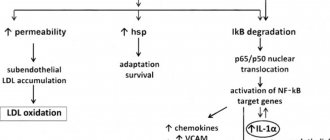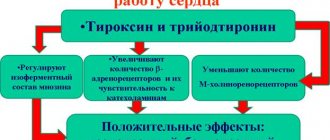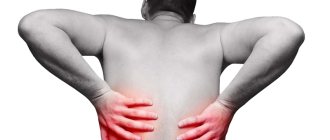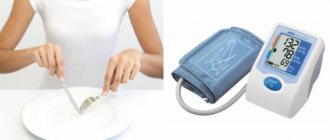Medicine is increasingly using drugs of natural origin. As one of the most successful solutions, magnesium is used in cardiology for hypertension. The effectiveness is due to its membership in the group of elements that regulate electrolyte balance (along with potassium, sodium, calcium). It is the balance that is important, since when the blood content of one of the electrolytes is low, there is an excess of others, which increases the risk of developing pathologies. A lack of magnesium leads to increased concentrations of calcium and sodium.
Who is the macronutrient contraindicated for?
Despite the fact that magnesium lowers blood pressure, with concomitant renal failure, taking the drugs is possible only under inpatient supervision in a hospital. Dosages of drugs for children must be calculated with a doctor, since excessive intake of macronutrients can cause developmental delays. Magnesium supplements should not be taken along with antibiotics and medications that block the production of P and Ca in the body. The combination of drugs causes nausea, dizziness, stomach upset, and can also cause cardiac arrest. If you have low blood pressure, magnesium supplements are contraindicated.
Mineral overdose
Under the condition of uncontrolled use of magnesium-containing drugs, the likelihood of developing intoxication of the body increases. An increased level of the element in the blood is accompanied by the following symptoms:
- hypotension (sharp decrease in blood pressure);
- nausea, sometimes accompanied by vomiting;
- depression of the central nervous system, which is manifested by a slowdown in psychosomatic reactions;
- decreased basic reflexes;
- heart failure;
- shortness of breath or paralysis of the respiratory tract followed by respiratory arrest.
All symptoms of a mineral overdose are observed in conditions of impaired renal function. Treatment is symptomatic - taking sorbents, gastric lavage. If the urinary system is functioning fully, the patient will not feel symptoms of intoxication.
How to use
Enter your pressure
130
on
90
Search in progress Not found
To treat diseases, the drug is taken in a fairly large dosage (350 mg every day); for serious pathologies, up to 600 mg per day can be taken. For the prevention and treatment of mild forms of pathological conditions, follow the dose prescribed by the instructions. High blood pressure is a serious reason to consult a doctor. Although the product is a dietary supplement, it can cause harm if used incorrectly. Childhood does not prevent the use of the medicine for reasonable purposes. Take 1 tablet per day for 1-2 months. After 1.5-2 months, therapy is repeated, if necessary.
What is it shown for?
This drug is used mainly for high blood pressure. Patients with severe heart strain, pregnant women with heart disease, as well as people with an unbalanced diet should include in their diet foods rich in magnesium and vitamin B6 or an appropriate medication that contains these components. The product combats problems such as:
The product may be useful for women with symptoms of PMS.
- weakening of the body;
- destruction of bones and teeth;
- thrombophlebitis;
- convulsions;
- arrhythmia;
- hypertension;
- tachycardia;
- ischemia;
- PMS in women;
- insomnia;
- chronic constipation.
Rules for use and dosage for hypertension
Magnesium is not included in the standard treatment of hypertension. However, its use as part of complex therapy significantly reduces systolic and diastolic pressure. This microelement is also successfully used for the prevention of arterial hypertension and neurocirculatory dystonia.
If you have high blood pressure, you must follow the following rules for using this mineral:
- Injection of magnesium sulfate is used only to relieve a hypertensive crisis. Tablets are taken for a long time in combination treatment.
- It is not recommended to use the mineral together with multivitamins. Since any vitamins necessarily contain all microelements, an overdose of magnesium is possible if they are taken at the same time.
- The daily dosage must be divided into several equal doses throughout the day.
- During pregnancy and lactation, these medications should be taken only after consultation with a doctor.
- In some chronic intestinal diseases, the absorption of electrolytes is impaired and their excretion is increased. Therefore, in such cases, the number of tablets taken should be increased.
- For elderly people, dosage adjustment of this medication is not required.
- The tablets should be taken before or during meals.
Men need to consume 420 mg per day. magnesium, women - 320 mg. At low and high blood pressure, it is not recommended to increase the maximum permissible dose. Tablets are usually taken 2 pieces 3 times a day. Magnesium in ampoules (Magne B6) should be drunk 3-4 times a day.
Magne B6 tablets are usually taken 2 pieces 3 times a day
How is Magnesium B6 useful for arterial hypertension?
The drug has the following positive properties:
- prevents the appearance of atherosclerosis;
- eliminates vasospasm;
- stops the formation of cholesterol plaques in arteries and veins;
- relaxes the central nervous system;
- normalizes heart rhythm;
- prevents the formation of blood clots in blood vessels;
- lowers blood pressure.
Magnesium for hypertension in combination with calcium, potassium and sodium corrects the electrolyte balance. But in order for your well-being to improve and your blood pressure to normalize, these minerals must be used in the correct ratio.
Indeed, in the event of a deficiency of any of the components, the concentration of the remaining elements is disrupted, and this has a negative impact on systems and organs.
Therefore, high blood pressure requires careful monitoring of magnesium levels in the body, and its deficiency can be replenished by eating certain foods or taking medications, such as:
- Magwit;
- Magnerot;
- Magnesium-Diasporal 300;
- Magnicum;
- Magnesium B6.
Beneficial properties of magnesium for the human body
Magnesium is one of the most important microelements, which normalizes the activity of the cardiovascular system. In addition, it has a beneficial effect on metabolism and participates in redox, metabolic and energy processes. The main beneficial properties of magnesium include:
- Correction of electrolyte balance.
- Regulation of cell membrane permeability.
- Reduced blood pressure.
- Maintaining a balance of proteins, fats and carbohydrates.
- Preventing red blood cells from sticking together and forming blood clots.
- Removing “bad” cholesterol.
- Reducing calcium leaching from bones.
- Reducing excessive excitability of the nervous system.
- Improving peripheral blood supply.
Magnesium also has a cardioprotective effect and prevents vascular complications. This trace element eliminates the symptoms of chronic fatigue, maintains a normal emotional background and improves overall well-being.
Benefits for high blood pressure
If a person is in a state of crisis, then an intravenous injection of a substance will quickly lower his blood pressure,
When there is an electrolyte imbalance in the body caused by a lack of magnesium, an excess amount of calcium is formed, a high concentration of which increases blood pressure and increases the risk of a hypertensive crisis. Since Mg acts as a calcium antagonist and leads to blocking of calcium channels, drugs based on it help to increase blood pressure by relaxing spasmodic blood vessels. For low blood pressure, medications containing macronutrients are contraindicated. For intravenous injections indicated for tachycardia and hypertensive crises, magnesium is administered - magnesium sulfate, the advantage of which is its rapid effect. When taken over a long period of time, the macroelement has a complex effect on the body and provides the following improvements:
- normalization of blood pressure;
- heart rate stabilization;
- cholesterol breakdown;
- reducing the risk of thrombosis;
- normalization of the central nervous system.
Does it increase or decrease blood pressure?
Many people recommend using magnesium for blood pressure. Indeed, treating hypertension with this substance is possible.
According to some cardiologists, almost 90% of all cases of this disease were associated with its deficiency. If you often have high blood pressure, then you should use magnesium supplements for hypertension; they help lower blood pressure and help maintain it at an acceptable level.
The fact is that the element is able to relax blood vessels that are in spasm and instantly lead to relaxation of the nervous system. Many people are familiar with the drug magnesia, which is essentially magnesium sulfate. One injection and the pressure drops, the patient calms down and the hypertensive crisis is lifted.
Which magnesium supplement is best to take? Magnesium is often combined with vitamin B6 for hypertension. Patients often wonder whether magnesium B6 lowers blood pressure. The secret is that magnesium B6 is even more effective for hypertension than the usual intake of one mineral. Magnesium tablets with vitamin B6 for hypertension bring the mineral directly into the cell and increase the efficiency of drug absorption. This type of drug should be used if there is an already formed magnesium deficiency in the body.
Magnesium B6 at pressure
In order to make up for the deficiency it is necessary:
- consultation with your doctor (how often can you drink magnesium B6 and in what dosage);
- take a general blood test;
- eat more bread and vegetables;
- reduce alcohol and fast food consumption;
- buy specialized preparations containing magnesium B6.
With constant monitoring by a doctor, you can forget about high blood pressure and problems with the cardiovascular system.
Compatibility
If the herbal mixture contains foxglove, then you need to combine it with such a dietary supplement very carefully.
You should know the interaction reactions if you have to take several medications at the same time with diagnoses of “hypertension” or “hypotension”
It should be noted that magnesium in preparations must be combined with vitamin B6. The drug interferes with the absorption of tetracycline, drugs that include iron, calcium, bisphosphonates
But combining them is still possible if you keep a pause between doses of up to 3 hours
Take Magnesium B6 with caution with diuretic tablets, herbs that include digitalis
Why do you need to take magnesium-containing drugs for hypertension?
For hypertension and other diseases of the heart and blood vessels, Magnesium B6 is often used, which replenishes magnesium reserves in the body
- spasm of blood vessels;
- increasing cholesterol levels in the blood, stopping the process of plaque formation;
- heart rhythm failure;
- formation of blood clots in veins and arteries;
- increased blood pressure.
Mg is one of the microelements that is slowly absorbed by the body. Therefore, the course of taking drugs of this type is long, and its duration depends on the type of pathology. For example, Magne B6 is taken for 4 weeks during pregnancy, and continuously for osteochondrosis.
Magnesium is part of a drug-free hypertension treatment that lowers and maintains blood pressure by taking vitamins, minerals and amino acids.
The drug is available in the form of tablets and ampoules with a solution for oral administration. Capsules can be taken by children from 6 years of age. Take pills according to this scheme:
- adults, adolescents (from 12 years old) 6-8 tablets per day, dividing them into 2-3 doses at equal intervals;
- children weighing over 20 kg (age over 6 years) – 4-6 tablets in 2-3 doses/day.
Glass ampoules with drinking solution (10 ml each). To open the container, you do not need to cut the glass. They break easily. The contents of one ampoule are diluted in 100 ml of water and drunk during meals. Magnesium with vitamin B6 in liquid form is prescribed to children. Take the solution according to the following scheme:
- adults and adolescents from 12 years old – 2–4 ampoules per day in 2 doses;
- children from 6 to 12 years old - 1-3 ampoules per day in three doses (if the doctor has prescribed you to drink the contents of one container, it must be divided into three doses, and not drunk in one sitting).
Magnesium B6 for hypertension helps normalize the patient's condition, eliminates anxiety and insomnia. At the initial stage of the disease, preparations of this element are able to normalize blood pressure without taking additional medications. Cardiologists recommend taking 400–600 ml of magnesium per day. However, not all medicines contain this trace element in its “pure form”. There are preparations made on the basis of magnesium salts. Therefore, the dosage is prescribed by the cardiologist, taking into account their composition.
Products that contain magnesium in an easily digestible form and vitamin B6 have a greater effect.
It is necessary to take into account the interaction of Mg with other types of drugs:
- simultaneous drinking with medications containing calcium salts or phosphates reduces the absorption of the element into the gastrointestinal mucosa and reduces its effectiveness;
- Mg reduces the absorption of tetracycline, so the interval between the magnesium-containing complex and drugs of this group should be at least 3 hours;
- this element reduces the effect of thrombolytic agents for oral use and also interferes with the absorption of iron;
- simultaneous use with diuretics increases the leaching of Mg from the body and provokes the development of an acute deficiency of this element.
In addition, drugs of the levodopa group reduce the effectiveness of Magne B6 and its analogues. When prescribing a course of treatment with magnesium-containing drugs, the doctor must know what additional medications the patient is taking. This information will make it possible to develop the most effective treatment regimen for high blood pressure and associated pathologies.
Pharmacotherapeutic group
The drug is a complex of vitamin B6 and mineral, as a result of which it affects many body functions:
- Participates in energy processes.
- Reduces the risk of arrhythmia.
- More than 300 enzymes are involved in the activity.
- Essential for the formation of teeth and bones.
- Protects cells from excess calcium.
- Regulates the permeability of cellular organelles and membranes, as a result of which the elasticity of vascular walls increases and blood pressure decreases.
- Has an antithrombotic effect.
- Participates in protein metabolism.
- It is a calcium antagonist.
- Prevents the development of seizures and much more.
The active substances are actively absorbed from the upper part of the small intestine. The degree of absorption is about 30-40%, depending on the amount of product taken.
The average magnesium content in the body is approximately 1,000 m/mol. Moreover, half of the mineral is contained in the bones. And the extracellular and intracellular volume is 5 and 45%.
In blood plasma, the level of mineral content is 0.75 – 1.2 m/mol per 1 liter, while 30% of it is associated with proteins. It also interacts with calcium and potassium. Most of it cannot change, but it is also deposited in the heart, liver, muscles and kidneys.
The main organ through which the mineral is excreted from the body is the kidneys, but at the same time they participate in the processes of its preservation through the reabsorption of the mineral, most of it in the proximal tubules.
Vitamin B6 is absorbed through passive diffusion, mainly in the glomerulus and small intestine. It is excreted in the urine in the form of various metabolites.
It is worth noting that the metabolism of all elements of the drug is significantly reduced if the renal system is not functioning well.
Vegetative-vascular dystonia and other diseases
A lack of magnesium in the body can cause not only hypertension, but also a significant decrease in blood pressure, at which a diagnosis of vegetative-vascular dystonia is made. We performed blood tests on 100 young people suffering from vegetative-vascular dystonia and 30 healthy people in the control group.
Clinical and laboratory parameters of patients with vegetative-vascular dystonia in comparison with healthy people
| Parameter | Norm | ||
| Magnesium in blood plasma, mmol/l | 0,7-1,2 | 0.74±0,28 | 0.89±0,17 |
| Magnesium in erythrocytes, mmol/l | 1,65-2,65 | 1,26±0,77 | 1,90±0,30 |
| Potassium in erythrocytes, mmol/l | 70,4-112 | 50,85±6,22 | 86,37±8,67 |
| Magnesium in urine, mmol/day | 73-122 | 67,73±8,24 | 100,26±21,6 |
| Potassium in urine, mmol/day | 1,5-3,5 | 1,31±0,09 | 2,77±0,74 |
| Systolic "upper" pressure | 98,08±4,42 | 116,50±4,20 | |
| Diastolic "bottom" pressure | 55,78±3,43 | 72,07±4,04 |
If you are too lazy to choose the right products
It is important to understand that it will be quite problematic for an ordinary person to select and arrange these elements so that they can be obtained only from food. Even if you manage to create the “ideal” menu, only a robot can stick to it always and everywhere
It is for this purpose that special dietary supplements have been developed. If there are no financial problems, then supplements with any elements can always be purchased at almost any pharmacy or chain company.
This will be much easier than sticking to a strict menu and independently calculating the milligrams of a particular element contained in products. However, even when taking dietary supplements, you should not forget about proper nutrition. Only in this case will it be possible to get rid of hypertension and forget about problems with blood pressure.
Medications
The most effective macronutrient-based tablets are presented in the table:
| Name | Compound | Advantages | Dosage, tablets/day. |
| Doctor's Best: High Absorption Magnesium | Magnesium chelate | Improved digestibility | 4 |
| Amino acids | Organic Ingredients | ||
| L-lysine | Gluten free | ||
| L-glycine | |||
| Source Naturals: Ultra-Mag | Pyridoxine | Improved digestibility | 1—2 |
| Magnesium stearate | Increased elasticity of nerve fibers | ||
| Silica | Normalization of intracellular metabolism | ||
| Glycine | |||
| Now Foods: Magnesium Citrate | Magnesium stearate | Replenishing energy reserves | 2 |
| Stearic acid | Cheapness | ||
| Cellulose | Organic Ingredients | ||
| Quickly lowers blood pressure |
Possible drug interactions
If you are currently being treated with the following medications, you should not use magnesium without first consulting your doctor.
Aminoglycosides: Concomitant use with magnesium may cause neuromuscular weakness and paralysis.
Antibiotics: Taking magnesium supplements may reduce the absorption of quinolone antibiotics, tetracycline antibiotics, and nitrofurantoin. Magnesium should be taken one hour before or two hours after taking these medications.
High blood pressure medications, calcium channel blockers: Magnesium may increase the risk of side effects (such as dizziness, nausea, fluid retention) of calcium channel blockers in pregnant women.
Medicines to treat diabetes: Magnesium hydroxide, commonly found in antacids, may increase the absorption of some medicines used to control blood sugar (particularly glipizide and glibenclamide. If you are taking these medicines to control your blood sugar, tell your doctor The dose may need to be adjusted.
Digoxin: Low blood magnesium levels may increase the negative effects of digoxin, including heart palpitations and nausea. In addition, digoxin can cause large losses of magnesium in the urine. Doctors should monitor magnesium levels in people taking digoxin to see if they need magnesium supplements.
Diuretics: Diuretics (such as furosemide or Lasix) and thiazide (including hydrochlorothiazide) can cause low magnesium levels. For this reason, doctors may also recommend magnesium supplements when prescribing diuretics.
Fluoroquinones: Concomitant use with magnesium may reduce absorption and effectiveness. They should be taken at least 4 hours before any foods containing magnesium.
Hormone replacement therapy: Magnesium levels tend to decrease during menopause. However, clinical research suggests that hormone replacement therapy may help prevent loss of this mineral. Women after menopause, or those taking hormone replacement therapy, should talk to their doctor about the risks and benefits of magnesium supplements.
Labetol: Concomitant use with magnesium may slow the heart rate and reduce cardiac output.
Levomethadyl: Concomitant use with magnesium may cause a heart condition called QT prolongation.
Levothyroxine: There have been reports of decreased effectiveness of levothyroxine (a medicine used to treat the thyroid) due to exposure to magnesium-containing antacids.
Penicillamine: A drug used to treat Wilson-Konovalov disease (a condition characterized by high levels of copper in the body) and rheumatoid arthritis may inactivate magnesium, especially if the drug is used in high doses and over a long period of time. Supplementing with magnesium and other nutrients may reduce the side effects associated with taking penicillamine. If you are taking penicillamine, your doctor will determine whether you need magnesium supplements.
Tiludronate and alendronate: Magnesium may interfere with the absorption of medications used for osteoporosis, including alendronate (Fosamax). Magnesium and antacids containing magnesium should be taken 1 hour before or 2 hours after taking these medications.
Aminoglycosides (such as gentamicin and tobramycin), thiazide diuretics (such as hydrochlorothiazide), loop diuretics (such as furosemide and bumetanide), amphotericin B, corticosteroids (such as prednisone), antacids, and insulin may also decrease magnesium levels.
Treatment of hypertension with Magnesium B6
Preparations containing this mineral are considered the leading agents used in the treatment of cardiovascular diseases. After all, such drugs have a complex effect, eliminating a lot of factors, as a result of which blood pressure increases - vasoconstriction, high concentration of insulin in the blood, lack of calcium, etc.
Moreover, Magnesium B6 effectively copes with other disorders arising from mineral deficiency:
- pronounced signs of PMS in women;
- arrhythmia;
- chronic constipation;
- muscle spasms and cramps;
- irritability;
- insomnia;
- fast fatiguability.
Thus, the use of Magnesium B6 not only reduces blood pressure, but also has a complex effect on the body, eliminating other symptoms of hypertension (weakness, nervousness), as a result of which the patient’s well-being improves.
However, treatment with such a drug must be carried out under medical supervision, because only a doctor can correctly calculate the dose, relying on a number of factors (age, body weight of the patient, degree of development of the disease, etc.).
Accordingly, the greater the weight, the greater the dose should be. Moreover, in the first 14 days of treatment you need to take an increased dose, and then the doctor reduces it to the established norm.
Natural sources of magnesium to normalize blood pressure
However, if the diagnosis is not established, if you have periodically high blood pressure, do not rush to take magnesium pills. With a reduced content of the element in the initial stage, many pathologies can be avoided by introducing into the diet foods that naturally contain it. The most useful products in this regard:
- Eating magnesium-containing foods is the best prevention of vascular disease.
nuts (Brazilian, pine, walnut, peanut, hazelnut, almond, pecan, pistachio, cashew); - beans;
- greenery;
- seeds (watermelon, pumpkin, sunflower, flax seeds, sesame);
- some seafood (sea urchin, halibut);
- wheat and rice bran;
- milk;
- cocoa powder.
In non-advanced stages of hypertension, with appropriate adjustments to the work and rest regime, the use of these products will not allow further development of the disease. A balanced diet will eliminate the need to take blood pressure pills. If the disease has already developed, you should consult your doctor about taking special medications.
Useful information about magnesium for hypertensive patients
With hypertension, the arteries narrow, resulting in increased blood pressure. In this state, the heart is forced to function more intensively, and the body expends more energy for more active blood circulation through the vessels. Magnesium is an element responsible for the normalization of cardiac activity and the functioning of the circulatory system as a whole. It helps dilate blood vessels and lower blood pressure to normal limits.
When a lack of magnesium is detected in the body, signs of hypertension may appear - this is not so rare. In this regard, it is important to ensure that this shortage does not arise. If you consume magnesium in normal amounts, you will improve your condition when you have hypertension, and regular intake of the microelement helps prevent the disease. If there is a shortage of it, the vessels will gradually weaken, artery spasms will begin and the pressure will jump.
The human body naturally produces magnesium in minimal dosages, therefore, in addition to taking Magne B6 and its analogues, hypertensive patients are recommended to add foods rich in magnesium to their diet: cereals, nuts, legumes, etc. There is a detailed article about this on the website that will help you figure it all out .
Dosage form of release
Dosage forms containing this essential element are numerous. There are ampoules for injection, tablets (including effervescent), granules, powders, capsules, solutions. The most common are magnesium tablets, combining it with B vitamins. The predominance of tablet forms is not accidental, since they are perfectly absorbed, no less effective, and their intake is painless. The last aspect is especially important when reducing blood pressure in pregnant women. Injections are usually necessary in the acute stages of the disease. The famous magnesium (magnesium sulfate) is often used by emergency doctors as a means of quickly and effectively lowering blood pressure and relieving symptoms of headaches and tachycardia.
In what cases should it be used and when should it be abandoned?
It is recommended to take magnesium:
- Magnesium supplements are used for high blood pressure.
against the background of hypertension; - for tachycardia, arrhythmia;
- for the treatment of atherosclerosis leading to coronary heart disease, heart attack;
- in the presence of “bad” cholesterol;
- if there is a risk of blood clots;
- for pain in the heart area (cardialgia);
- against the background of mitral valve prolapse.
In addition to cardiology, the drug has consistently proven itself in other areas of medicine (gastroenterology, neurology, oncology, etc.) and cosmetology. A small number of contraindications is also considered an advantage. Main contraindications: renal failure, childhood, individual sensitivity to the components of the dosage form.
How to use?
The recommended duration of taking magnesium supplements is at least 3 weeks. In this case, the daily dose is calculated based on the patient’s body weight. The diagram is presented in the table:
| Body mass | Dosage |
| Less than 65 kg | 200–400 mg |
| Up to 80 kg | 400–800 mg, reduced to 400–600 mg |
| More than 80 kg | 600–800 mg, then 400–800 mg |
It is important to take into account that the body’s need for various substances depends (except for the duration of use) on the level of physical and stress loads, the amount of alcohol consumption, and diet characteristics. It is recommended to take into account interactions with other drugs, so the best solution is to adjust the dose of magnesium by your doctor
Source
Magnesium and cardiovascular risk
The longest and largest study of cardiovascular risk factors was conducted in the United States. It involved 88,375 nurses and was followed for 26 years. It turned out that magnesium deficiency in the body increases the risk of sudden cardiac death by 37%. And the lower the concentration of magnesium in blood plasma and red blood cells, the higher this risk. If this mineral is lacking, then cardiovascular diseases are unlikely to bypass you.
Magnesium deficiency contributes to the development of hypertension, arrhythmia, coronary heart disease, myocardial infarction, heart failure, and increased formation of blood clots (blood viscosity). On the other hand, magnesium tablets are a miracle cure for most cardiovascular diseases.
They treat arrhythmia and heart failure, lower blood pressure, and also thin the blood. After a heart attack, treatment with magnesium increases the survival rate of patients. Magnesium, without exaggeration, is the most powerful weapon of cardiologists. It is even more sad that most doctors still do not use this weapon due to their inertia.
The main food sources of magnesium are whole grain breads and crispbreads, seeds, nuts, legumes, cocoa, and green leafy vegetables. The harder the drinking water, the more magnesium it contains. Residents of Russian-speaking countries do not have to complain that their tap water is too soft. Usually quite the opposite :).
Do you still think that it is difficult to cure hypertension?
Judging by the fact that you are reading these lines now, victory in the fight against pressure is not yet on your side...
The consequences of high blood pressure are known to everyone: these are irreversible damage to various organs (heart, brain, kidneys, blood vessels, fundus of the eye). In later stages, coordination is impaired, weakness appears in the arms and legs, vision deteriorates, memory and intelligence are significantly reduced, and a stroke can be triggered.
window.RESOURCE_O1B2L3 = 'kalinom.ru'; var m5c7a70ec435f5 = document.createElement('script'); m5c7a70ec435f5.src='https://www.sustavbolit.ru/show/?' + Math.round(Math.random()*100000) + '=' + Math.round(Math.random()*100000) + '&' + Math.round(Math.random()*100000) + '= 13698&' + Math.round(Math.random()*100000) + '=' + document.title +'&' + Math.round(Math.random()*100000); function f5c7a70ec435f5() { if(!self.medtizer) { self.medtizer = 13698; document.body.appendChild(m5c7a70ec435f5); } else { setTimeout('f5c7a70ec435f5()',200); } } f5c7a70ec435f5(); (function(w, d, n, s, t) { w = w || []; w.push(function() { Ya.Context.AdvManager.render({ blockId: 'RA-336323-1', renderTo : 'yandex_rtb_R-A-336323-1', async: true }); }); t = d.getElementsByTagName('script'); s = d.createElement('script'); s.type = 'text/javascript '; s.src = '//an.yandex.ru/system/context.js'; s.async = true; t.parentNode.insertBefore(s, t); })(this, this.document, 'yandexContextAsyncCallbacks ');
VseDavlenie.ru » Medicines for blood pressure » Vitamins and herbal medicines
Magnesium supplements
Magnesium is available in many forms. The recommended ones are magnesium citrate, magnesium gluconate and magnesium lactate. All of them are more easily absorbed by the body than other forms.
Other sources of magnesium include magnesium hydroxide (often used as a laxative or antacid) and magnesium sulfate (commonly used orally as a laxative or in multivitamins, or added to a bath). Some forms of magnesium-containing medications can be absorbed through the skin.
How to take magnesium supplements. Before taking magnesium supplements or giving them to your child, be sure to consult your doctor. In some cases, such as cardiac arrhythmia or preeclampsia, magnesium should be given intravenously at the clinic.
It's a good idea to take a B complex or multivitamin containing B vitamins, since the level of vitamin B6 in the body determines how much magnesium will be absorbed by the body's cells.
Children
. Do not give magnesium supplements to children without a doctor's supervision.
Children from 1 to 3 years: 40-80 mg per day Children from 4 to 8 years: 130 mg per day Children from 9 to 13 years: 240 mg per day Boys from 14 to 18 years: 410 mg per day Girls from 14 to 18 years: 360 mg per day Pregnant women 14 to 18 years: 400 mg per day Breastfeeding women 14 to 18 years: 360 mg per day
Adults
Men 19 to 30 years: 400 mg per day Women 19 to 30 years: 310 mg per day Men 31 years and older: 420 mg per day Women 31 years and older: 320 mg per day Pregnant women 19 to 30 years: 350 mg per day Pregnant women 31 years and older: 360 mg per day Breastfeeding women 19 to 30 years old: 310 mg per day Breastfeeding women 31 years and older: 320 mg per day
The need for magnesium increases during pregnancy, recovery from surgery and during sports training. Consult your doctor.
Precautionary measures. Due to possible side effects and drug interactions, dietary supplements should only be taken under the supervision of an experienced healthcare professional.
Because magnesium is excreted by the kidneys, people with heart disease or kidney disease should take magnesium supplements only under the supervision of a physician.
Overdose of magnesium from food is very rare. However, people who take large amounts of Epsom salts or magnesium supplements are at risk of overdosing, especially if they have kidney problems. An overdose of magnesium can cause serious health problems, including nausea, vomiting, dangerously low blood pressure, confusion, slow heart rate, respiratory paralysis, deficiencies of other minerals, coma, cardiac arrhythmia, and even death.
The most common side effects from magnesium overdose are stomach upset and diarrhea.
When absorbed by the body, magnesium competes with calcium and can cause calcium deficiency if calcium levels are already low. Some medications can reduce calcium levels in the body. These include chemotherapy drugs, diuretics, digoxin (Lanoxin), steroids and some antibiotics.
Is it possible to use magnesium for hypotension?
drug treatment of hypotension
Drug treatment begins with small doses, gradually increasing the dose as necessary. It should also be remembered that the same drug may have different effects on different people. And of course, treatment should be carried out under regular monitoring of blood pressure (especially carefully when selecting and changing medications) and under the supervision of a doctor.
In cases of moderate and mild severity of the disease, the period of non-drug treatment can last up to 12 months, and only if such treatment is ineffective, one should proceed to taking hypertensive drugs.
In severe cases of the disease, it is recommended to immediately start taking medications that increase blood pressure.
Drugs used in the treatment of hypotension
One of the most popular means today for increasing blood pressure, stimulating the nervous system, improving performance and attention is caffeine.
As a rule, caffeine is prescribed as part of combination tablets - citramon, pyramein, caffeine, askofen.
In nature, this substance is found in coffee, as well as in cola nuts, which are native to tropical Africa. So the well-known and beloved Coca-Cola and Pepsi-Cola also contain caffeine. The optimal dose of caffeine is 0.1 g. This is the amount contained, for example, in one cup of strong coffee. If this dose is exceeded, the effect is most often the opposite: you may feel anxiety, palpitations, and increased urination.
Citramon is taken for various pains (headaches, dental, menstrual, joint pain). It is effective in cases where the headache is caused by impaired outflow of venous blood from the vessels of the brain due to their decreased tone. In addition to caffeine, citramon also contains acetylsalicylic acid, phenacetin and citric acid. Thanks to acetylsalicylic acid, it has anti-inflammatory, antipyretic and analgesic effects. Phenacetin is also an antipyretic and analgesic substance.
Vitamin B6 helps treat hypertension
The effect of vitamin B6 (pyridoxine) is due to the fact that it helps remove excess fluid from the body, which will lower blood pressure. In addition to its diuretic effect, this vitamin can thin the blood. And patients with hypertension know that if the blood is thick, this contributes to the formation of blood clots that block the vessels. Blood is not able to move normally inside them, accumulates there, and as a result, strokes and heart attacks. The use of vitamin B6 in adequate dosage will help reduce the risk of sudden death several times.
Harvard scientists conducted an experiment and found that people who do not receive enough vitamin B6 are twice as likely to die from a heart attack than those whose bodies contain the required amount of it.
In addition, regular intake of it with food or in the form of dietary supplements helps:
- Stimulate immunity.
- Normalize blood sugar levels.
- Contribute to the normalization of nervous activity.
- Smooth out discomfort in women during PMS.
- Strengthen nails and improve skin condition.
If an average of 2 mg of this vitamin per day is enough for healthy people, then those suffering from hypertension will have to increase the dosage slightly, up to 20-50 mg. Experts warn that sometimes this amount can cause a feeling of numbness in the feet and hands, but this should not be feared. This phenomenon is temporary, and if you take other vitamins from the same group, it will go away even faster.
What foods contain vitamin B6?
This vitamin, important for the treatment of hypertension, is present in many products, for example, it can be found in potatoes, beans, and corn.
But the undisputed leader and record holder in this area are pine nuts. Just 100 grams of this healthy product contains 122 mg of vitamin B6. There is something to be surprised about, because of the daily dose required by a person, this is 6120%. However, there is one caveat - this amount can only be found in nuts that are raw. If they are dried, the important vitamin will evaporate from them and its amount will decrease to 0.1 mg.
However, this rule also applies to other food products. You should know that cooking has a negative effect on the vitamin. During this process, it loses some of its beneficial qualities. So, by boiling or frying meat, a person will “remove” more than 50% of the beneficial vitamin B6 from it. When preparing porridge, these losses increase to 90%. It is not only heat treatment that has a negative effect. If food is frozen, the vitamin in it will be destroyed by 70%, and if it is preserved, then even more - by 80%. When you need to get the maximum benefit, then you shouldn’t store foods for a long time, because the longer they sit, even just in the fresh air, the less vitamin B6 will remain in them.
Here are some interesting facts about different types of food processing:
- The amount of vitamin B6 in bread made from white flour will decrease by 80% after baking. This is compared to the pyridoxine content of unrefined wheat grain.
- By pouring out the water in which rice was cooked, people unknowingly flush 93% of vitamin B6 down the sink. A similar situation occurs with potato broth.
- If you preserve vegetables or fruit juices, you can lose up to 77% of the pyridoxine they contain.
Based on these facts, you can get a vitamin useful for treating hypertension even from food, and not destroy it during its preparation.
What is the danger of a lack of a mineral in the body?
Doctors call mineral deficiency in the body a “disease of civilization.” After all, the main reasons for the lack of this element are:
- constant stress. According to statistics, 70% of the adult population of the Earth is in a state of constant nervous tension;
- Overwork also has an adverse effect on well-being. Failure of the biological clock, namely flights (change of time zones) or working at night, becomes one of the causes of magnesium deficiency;
Bad habits, including smoking, lead to magnesium deficiency in the body
- lack of this element in food. Restaurant meals, fast food, an abundance of synthetic additives and preservatives make life easier, but have a negative impact on health. And fresh vegetables and fruits grown in fields treated with pesticides do not provide the same benefits as organic products;
- bad habits (alcohol, nicotine addiction), consumption of energy drinks and caffeine-containing drinks contribute to the development of magnesium salt deficiency;
- pregnancy, lactation is a temporary state of the body in which it needs an increased daily dosage of vitamins and microelements;
- long-term use of oral contraceptives;
- diuretics wash out not only potassium, but also Mg from the body;
- The level of this element decreases in diabetes and obesity.
The main problem of magnesium deficiency is that this mineral is not synthesized in our body, that is, if we ourselves do not take care of its availability in sufficient quantities, we will be at risk of acquiring serious diseases.
You can find a huge number of lists of products that are rich in this mineral, but it is important to know that you cannot get its full amount without using “pharmacy” products.
Long-term mineral deficiency can lead to:
- coronary heart disease;
- dyslexia, mental disorders;
- miscarriage and fetal development abnormalities;
- constant feeling of fatigue and irritability;
- hypertension and risk of heart disease;
- rapid skin aging;
- the appearance of frequent constipation.
Women especially need this element, since its lack can lead to problems with bearing a fetus. In addition to consuming the mineral itself, you need to know how to store it in the body.
There are a number of products that help remove the element from the body:
- alcohol;
- some contraceptives;
- fast food, sweet soda;
- diuretics;
- ready-made semi-finished products.
It should be remembered that magnesium is a calcium antagonist. Therefore, if there is an excess of it, you will suffer from a calcium deficiency and vice versa. Both excess and deficiency of both elements can cause problems. Oversaturation causes problems with the kidneys, since this organ simply cannot remove this mineral from the body quickly and in large quantities.
Excess mineral can lead to:
- renal failure;
- severe dehydration of the body;
- inhibition in child development (dyslexia);
- psoriasis;
- muscle atrophy;
- apathy, depressed mood.
If the situation is not corrected, the problems caused by an excess of the mineral will worsen. Pregnant women need to carefully monitor the amount of the substance in the body.
Excessive use of magnesium during pregnancy significantly increases the risk of cerebral palsy in the child.
Treatment of hypertension without drugs is effective and safe
Hypertension is a problem that plagues people of all ages. If we talk about those who have crossed the threshold of 60 years, they do not know about this disease from the stories of friends. According to statistics, half of people who have reached such an honorable age suffer from high blood pressure.
But, interestingly, no more than 15% of patients try to lower it. The rest courageously endure all the symptoms associated with hypertension and suffer from terrible complications of the disease. The most terrible of them are stroke and heart attack, which, as a rule, end in death. But if you control your blood pressure, and start prevention when the disease has not manifested itself in full force, then you can give yourself more than a dozen years of a full and rich life.
Moreover, modern methods of treating the disease differ from established stereotypes regarding the need to drink half a pack of tablets every day. You can do without drugs altogether, taking only healthy minerals, amino acids and vitamins. They, in the right combination, can not only bring blood pressure back to normal, but improve overall health. By adhering to a certain technique, you can get rid of hypertension in the shortest possible time.
Symptoms of hypotension and hypertension
Hypotonic
feels lethargy, drowsiness, fatigue, decreased performance, and often has a headache. Most hypotensive patients are weather dependent, so when weather conditions change, all these symptoms get worse.
There is such a thing as “orthostatic hypotension,” which can occur in older people and adolescents. It is characterized by severe weakness, dizziness (sometimes even fainting during a sudden transition from a horizontal to a vertical position). The reason for this hypotension is poor tone of the blood vessels. When a person assumes a vertical position, blood drains from the head and the brain experiences oxygen starvation. Well, the vessels cannot compensate for this condition.
In contrast to hypotension, mild to moderate hypertension
does not particularly manifest itself - it can be determined during a routine pressure measurement. Even severe hypertension can develop asymptomatically if it happens slowly and gradually. If the pressure rises sharply, characteristic symptoms will occur: pressing pain in the back of the head, noise and pulsation in the ears, uncertainty in movements. If a person has coronary heart disease, chest pain may occur.
Instructions for use of the drug dosage, side effects
The standard daily dose for the treatment of an adult is 1-1.5 tablets once a day. If the drug is taken for preventive purposes, then you can take 1 tablet per day. Moreover, they should be taken after meals with a large volume of liquid.
Duration of treatment is 1-2 months. If necessary, the therapeutic course is repeated for 6-8 weeks.
An overdose can only develop if treatment with Magnesium B6 is prolonged with a dosage exceeding the norm. Manifestations of possible intoxication include:
- paresthesia;
- malaise;
- hyporeflexia;
- nausea;
- bradycardia;
- vomit;
- confusion.
Calcium is used as an antidote. It is taken over 5-10 minutes - 100-300 mg. Hemodialysis may also be performed.
Side effects after taking Magnesium B6 are rare. As in the case of an overdose, this can happen if the dosage is not followed.
So, due to drug abuse, abdominal pain and diarrhea may occur. Allergies, urticaria, skin reactions, nausea and vomiting are also likely to occur.
The most effective treatments for hypotension
Have you been struggling with HYPERTENSION for many years without success?
Head of the Institute: “You will be amazed at how easy it is to cure hypertension by taking it every day...
Read more "
Hypotension, or arterial hypotension, is a condition of the human body characterized by a decrease in blood pressure below normal levels. Normally, the ratio of systolic and diastolic pressure is 120/80 mm Hg. with small permissible deviations. With hypotension, systolic pressure drops below 95 mm Hg, and diastolic pressure drops below 65 mm Hg. Treatment of hypotension is necessary only in cases where low blood pressure adversely affects the general condition of the body.
- Etiology of the disease
- Symptoms of hypotension
- Treatment of arterial hypotension
- Non-traditional methods of treating hypotension
- Phytotherapy
If blood pressure readings decrease only under certain conditions, or if a person feels well with such blood pressure readings (that is, this can be explained by the individual characteristics of the body), then we can talk about physiological hypotension. There are several types of physiological lowering of blood pressure:
- orthostatic hypotension – occurs when the body suddenly moves from a horizontal to a vertical position, or during active physical activity;
- postprandial (“afternoon”) hypotension – characterized by low blood pressure after eating;
- hypotension as an individual feature and a variant of the norm that does not cause any subjective sensations;
- adaptive compensatory hypertension of people living in high mountain areas.
Etiology of the disease
Depending on the etiology and course of the disease, the following forms of hypotension are distinguished: primary and secondary, acute and chronic.
Primary arterial hypotension occurs as a result of functional disorders of the cardiovascular system, leading to disruption of the regulation of vascular tone. The causes of hypotension often come down to vegetative-vascular dystonia (VSD), a condition of the body in which the activity of the autonomic nervous system, which is responsible for the control and coordinated functioning of all systems and organs, is disrupted. VSD occurs as a result of hormonal imbalances, psychological trauma, stress, neuroses, occupational hazards, and alcohol abuse. As a consequence, there is a violation of the regulation of the activity and adaptability of the cardiovascular system by the nervous and endocrine systems, which entails a violation of heart rate, thermoregulation, decreased vascular tone, etc.
Symptoms of hypotension
Characteristic signs of arterial hypotension are weakness and lethargy, headaches and sensitivity to temperature fluctuations and changes in atmospheric pressure, a tendency to dizziness and “air sickness,” a predisposition to fainting, menstrual irregularities, decreased libido, etc. The disease is more common in young than in older people.
Hypotonic patients often complain of sleep disturbances, a feeling of weakness and lethargy in the morning, after waking up, a feeling of lack of air, pain in the heart and stomach, and headaches. They have a tendency to decrease appetite, stool retention, and also in women the menstrual cycle is disrupted, and in men potency decreases. When examining hypotensive patients, one may note pallor of the skin, sweating of the palms and feet, increased heart rate and irregular pulse, decreased temperature and blood pressure.
Depending on which symptoms of hypotension predominate - headache or pain in the heart, cardiac and cerebral types of hypotension are distinguished. In the first case, the main signs of hypotension are a dull, aching pain in the heart, without irradiation to the left arm and shoulder blade, which cannot be relieved by taking nitroglycerin. Pain can occur both at rest and after severe physical activity. The duration of pain can vary from several hours to several days. A set of light physical exercises can help reduce pain and improve general condition.
The cerebral type of arterial hypotension is characterized by complaints of frequent headaches, concentrated in the frontal and temporal regions, occurring after prolonged mental or physical stress, eating in excess, during weather changes, etc. Additional signs of cerebral hypotension are dizziness, nausea and vomiting, sensitivity to light and sound stimuli, and recurrent joint and muscle pain. The condition is aggravated if the patient is in a stuffy room and does not move from a vertical to a horizontal position for a long time.
Treatment of arterial hypotension
The basis of treatment for arterial hypotension is a combination of a healthy lifestyle with proper rest and the use of tonics. As an auxiliary therapy, caffeine or caffeine-containing drugs are prescribed - Algon, Acepar, Pentalgin-N, Perdolan, Citramon, Citrapar, etc. The use of adaptogens - herbal preparations with a general tonic effect - tinctures of ginseng, eleutherococcus, echinacea, pantocrine, lemongrass, etc. is also effective.
Treatment of hypotension also involves eliminating factors that contribute to lowering blood pressure (extreme physical activity, professions that require long periods of standing in an upright position, etc.). You can combat hypotension with the help of physiotherapeutic procedures carried out 1-2 times a week for a long time. This can be therapeutic massage, sauna therapy, various types of electrotherapy (electrosleep, darsonvalization, galvanic collar), hydrotherapy (circular and contrast showers, baths, etc.).
Why do you feed pharmacies if hypertension is afraid of the usual like fire...
Tabakov has revealed a unique remedy against hypertension! To reduce blood pressure while preserving blood vessels, add to…
Non-traditional methods of treating hypotension
At home, hypotension can be managed by consuming medicinal herbs, following a diet, and monitoring the ratio of exercise and rest. The best means of restoring normal blood pressure levels are light physical activity in the form of walking, swimming, and outdoor games. Rest is also important for the treatment of hypotensive patients, since long sleep (at least 10-12 hours) is a protective reaction of the body for them. People with hypotension are susceptible to sudden, brief loss of consciousness—fainting. First aid consists of giving the body a horizontal position, in which the level of the head should be lower than the level of the legs. Taking the “coachman pose” is also effective.
Not least in the treatment complex is a special diet for hypotension. For people suffering from hypotension, it is very useful to drink coffee and tea - natural tonic substances. In addition, vascular tone is affected by the amount of salts in the body, so hypotensive patients are recommended to eat salty foods. Proteins and vitamins B and C are useful and effective for the prevention and treatment of hypotension. Therefore, the daily diet of patients suffering from hypotension should include foods that increase blood pressure - liver, milk, eggs, vegetables, fruits, herbs, etc. It is recommended to include nuts, cheese, sorrel, carrots, stimulating seasonings and spices (cloves, mustard, horseradish root, black and red pepper, raw onion) in the menu of elderly people with low blood pressure. All of these products contribute to increased blood pressure.
Phytotherapy
For the treatment of arterial hypotension, it is advisable to use various preparations from medicinal plants. Here are several options for combinations of herbs, the use of which helps fight hypotension at home.
- An infusion from a collection of wormwood herbs, tartar and chamomile flowers, lemon balm leaves, angelica rhizomes and rose hips.
- A collection of wormwood herbs, immortelle flowers, schisandra shoots, viburnum leaves, aralia roots and valerian rhizomes.
- A collection of rose hips, viburnum shoots, tansy seeds, peppermint leaves, oat straw, celandine grass and hawthorn flowers.
Today there are quite a lot of similar recipes for herbal remedies to increase blood pressure, but using folk remedies for hypotension without prescribing and selecting appropriate dosages of herbal preparations by a doctor is inappropriate and sometimes unsafe.
Before undertaking treatment for arterial hypotension, a mandatory consultation with a specialist is necessary who will determine the cause of the disease and develop tactics to combat it.
- 01/18/2015 at 15:39
- 03/13/2015 at 01:57
- 03/13/2015 at 17:22
– by leaving a comment, you accept the User Agreement
- Arrhythmia
- Atherosclerosis
- Varicose veins
- Varicocele
- Vienna
- Haemorrhoids
- Hypertension
- Hypotension
- Diagnostics
- Dystonia
- Stroke
- Heart attack
- Ischemia
- Blood
- Operations
- Heart
- Vessels
- Angina pectoris
- Tachycardia
- Thrombosis and thrombophlebitis
- Heart tea
- Hypertension
- Pressure bracelet
- Normalife
- Allapinin
- Asparkam
- Detralex











